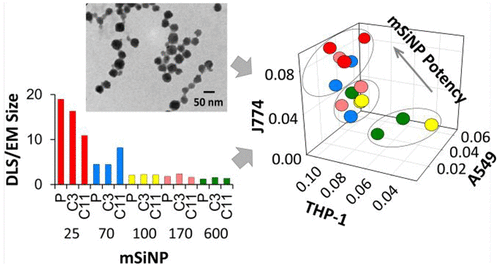Our official English website, www.x-mol.net, welcomes your feedback! (Note: you will need to create a separate account there.)
Physicochemical Properties Can Be Key Determinants of Mesoporous Silica Nanoparticle Potency in Vitro
ACS Nano ( IF 17.1 ) Pub Date : 2018-11-26 00:00:00 , DOI: 10.1021/acsnano.8b04910 Dalibor Breznan , Dharani D. Das , Christine MacKinnon-Roy , Stéphane Bernatchez , Abdelhamid Sayari 1 , Myriam Hill , Renaud Vincent , Prem Kumarathasan
ACS Nano ( IF 17.1 ) Pub Date : 2018-11-26 00:00:00 , DOI: 10.1021/acsnano.8b04910 Dalibor Breznan , Dharani D. Das , Christine MacKinnon-Roy , Stéphane Bernatchez , Abdelhamid Sayari 1 , Myriam Hill , Renaud Vincent , Prem Kumarathasan
Affiliation

|
Nanoforms of mesoporous silica (mSiNPs) are increasingly applied in medicine, imaging, energy storage, catalysis, biosensors, and bioremediation. The impact of their physicochemical properties on health and the environment remain to be elucidated. In this work, newly synthesized mesoporous silica (sizes: 25, 70, 100, 170, and 600 nm; surface functionalization: pristine, C3-, and C11-COOH moieties) were assessed for cytotoxicity and induction of inflammatory responses in vitro (A549, THP-1, J774A.1 cells). All toxicity end points were integrated to obtain simple descriptors of biological potencies of these mSiNPs. The findings indicate that mSiNPs are less bioactive than the nonporous reference SiNP used in this study. The C3-COOH-modified mSiNPs were generally less cytotoxic than their pristine and C11-modified counterparts in the nanorange (≤100 nm). Carboxyl-modified mSiNPs affected inflammatory marker release across all sizes with cell-type specificity, suggesting a potential for immunomodulatory effects. Surface area, size, extent of agglomeration, ζ-potential, and surface modification appeared to be important determinants of cytotoxicity of mSiNPs based on association tests. Pathway analysis identified particle and cell-type-specific alteration of cellular pathways and functions by mSiNPs. The integration of exposure-related biological responses of multiple cell lines to mSiNPs allowed for a comprehensive evaluation of the impact of physicochemical factors on their toxicity characteristics. The integrated multilevel toxicity assessment approach can be valuable as a hazard screening tool for safety evaluations of emerging nanomaterials for regulatory purpose.
中文翻译:

理化性质可能是决定介孔二氧化硅纳米粒子体外效能的关键因素
介孔二氧化硅(mSiNPs)的纳米形式正在越来越多地应用于医学,成像,能量存储,催化,生物传感器和生物修复。其理化性质对健康和环境的影响尚待阐明。在这项工作中,评估了新合成的介孔二氧化硅(尺寸:25、70、100、170和600 nm;表面功能化:原始,C3-和C11-COOH部分)的体外细胞毒性和炎症反应的诱导作用。(A549,THP-1,J774A.1细胞)。整合所有毒性终点以获得这些mSiNPs生物学效能的简单描述。研究结果表明,mSiNPs的生物活性低于本研究中使用的无孔参考SiNP。C3-COOH修饰的mSiNP在纳米范围内(≤100nm)通常比其原始的和C11修饰的对应物具有更低的细胞毒性。羧基修饰的mSiNPs通过细胞类型特异性影响所有大小的炎症标志物的释放,提示可能具有免疫调节作用。根据缔合试验,表面积,大小,团聚程度,ζ电位和表面修饰似乎是mSiNPs细胞毒性的重要决定因素。途径分析鉴定了mSiNPs对细胞途径和功能的颗粒和细胞类型特异性改变。多个细胞系对mSiNPs的暴露相关生物反应的整合允许对理化因素对其毒性特征的影响进行全面评估。集成的多级毒性评估方法可以作为一种危害筛查工具,可用于监管目的对新兴纳米材料进行安全性评估的价值。
更新日期:2018-11-26
中文翻译:

理化性质可能是决定介孔二氧化硅纳米粒子体外效能的关键因素
介孔二氧化硅(mSiNPs)的纳米形式正在越来越多地应用于医学,成像,能量存储,催化,生物传感器和生物修复。其理化性质对健康和环境的影响尚待阐明。在这项工作中,评估了新合成的介孔二氧化硅(尺寸:25、70、100、170和600 nm;表面功能化:原始,C3-和C11-COOH部分)的体外细胞毒性和炎症反应的诱导作用。(A549,THP-1,J774A.1细胞)。整合所有毒性终点以获得这些mSiNPs生物学效能的简单描述。研究结果表明,mSiNPs的生物活性低于本研究中使用的无孔参考SiNP。C3-COOH修饰的mSiNP在纳米范围内(≤100nm)通常比其原始的和C11修饰的对应物具有更低的细胞毒性。羧基修饰的mSiNPs通过细胞类型特异性影响所有大小的炎症标志物的释放,提示可能具有免疫调节作用。根据缔合试验,表面积,大小,团聚程度,ζ电位和表面修饰似乎是mSiNPs细胞毒性的重要决定因素。途径分析鉴定了mSiNPs对细胞途径和功能的颗粒和细胞类型特异性改变。多个细胞系对mSiNPs的暴露相关生物反应的整合允许对理化因素对其毒性特征的影响进行全面评估。集成的多级毒性评估方法可以作为一种危害筛查工具,可用于监管目的对新兴纳米材料进行安全性评估的价值。



























 京公网安备 11010802027423号
京公网安备 11010802027423号